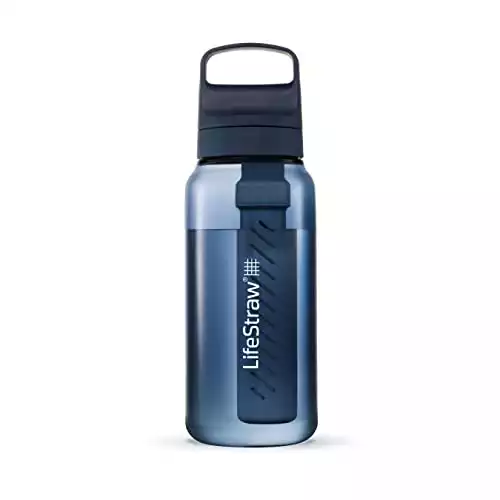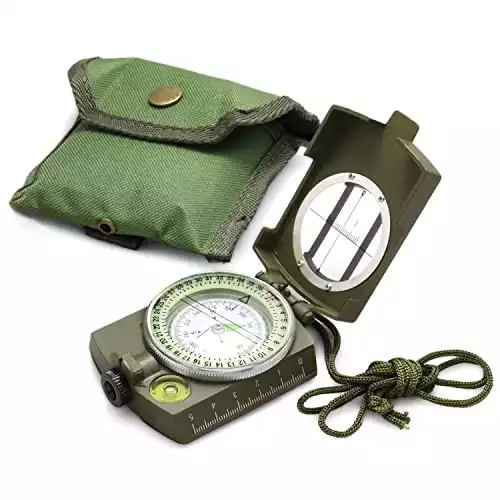The average American spends 12.5% of our waking time in their cars. If a disaster strikes, there is a good possibility it will happen while you are in your car.
In a disaster situation, you may need to flee with your car. And there is a good chance that your car will be the cause of the disaster – like if you slide off the road and get stuck in a ditch.
For these reasons, it is incredibly important to have a car emergency kit.
I’ve divided up this car emergency kit checklist into 8 essential categories based on function. With some of the categories, you’ve got a lot of flexibility to choose products for your specific needs. Just make sure you don’t overlook any categories of you could find yourself in a really perilous situation!
Emergency Food and Water
Keep at least 3 days worth of food and water in your car. It might seem excessive, but you’ll be happy to have this reserve if you must flee a disaster.
Trust me, you won’t want to waste any time battling the hungry masses in the supermarkets!
I keep a 5-gallon jug of water in my trunk and some emergency packs of water. I also have this water filtration bottle (pictured) in my trunk.
If water were to run out, I could even drink gross gutter water through it.
As for food, I keep a bunch of energy bars in the car kit. They are great because they are high calorie but don’t take up much space. Have a look at these 3600 calorie bars on Amazon.
However, the problem is that they are tasty and you might eat them too quickly.
A weird tip from the Canadian Arctic Team is to bring a can of dog food in your car. The idea is that it tastes terrible (but is edible), so you won’t be tempted to go through it too quickly.
I think I will opt for a can of Spam or something else unappetizing instead!
Emergency Clothes and Shoes
Emergencies aside, having a spare set of clothes in your car is good practice. You never know when an accident might occur – like spilling your coffee all over yourself – and need to change your clothes.
Just make sure you pack practical clothes in your emergency car kit.
You will want:
- Jeans
- Loose, comfortable shirt
- Warm jacket (fleece is good)
- Rain jacket or survival poncho
- Sneakers/boots
My wife isn’t exactly the type who trots around in high heels, but she does occasionally wear them.
Imagine how terrible it would be if she broke down while wearing heels and had to walk miles in them? Or had to flee while wearing heels? Not good!
The same goes for flip-flops. That is why we also keep a spare pair of sneakers in the car emergency kit.
Map and Compass
Don’t count on your GPS to guide you through an emergency! If your car goes dead, the GPS likely will too. Certain disasters, like an EMP attack, would also destroy GPS devices (more on EMP and your car here).
Keep maps of the local and greater area in your car and a compass. Oh, and it will help if you LEARN HOW TO READ A MAP!
Warmth
If your car breaks down in the middle of a snowstorm, it will help protect you from the elements – but it won’t be very warm inside! At the very least, you’ll want to have:
- Wool blanket: works well even if it gets wet
- Emergency Mylar blanket: these “space blankets” reflect your body heat back at you; they are great after an accident
- Hand warmers: these aren’t entirely essential, but they don’t take up much space and will save your fingers and toes from frostbite in winter emergency situations
- Matches or matchless fire starter: If you have to leave your car, you can light a fire to stay warm
You might also want to keep a sleeping bag and tent in your car, especially if you need to flee somewhere quickly.
A plastic tarp also works great to create an emergency shelter.
First Aid
See our post about first aid kits to learn what you should put in your kit.
Mechanical and Car Repair Items
I’ve got to be honest: I’m not much of a mechanic. Today’s cars have too many electronics and gadgets for me to be able to fix. And I’m sure I’m not alone in this.
However, that doesn’t change the fact that you should always have some basic repair tools in your car emergency kit.
You should also know how to do the basic repairs – like changing a tire, jumpstarting the engine, cleaning the air filter, and hooking up your car to tow.
Here is a list of essential car repair items to include in your emergency kit:
- Vise grips
- Adjustable wrench
- Phillips head screwdriver
- Flat head screwdriver
- Pliers
- Tire inflator
- Tire pressure gauge
- Gas can
- Gas siphon – more on siphoning gas
- Pocket Jump Starter
- Brake fluid
- Antifreeze (1 gallon)
- Transmission fluid
- Oil (2 quarts)
- Spare fuses
- Ice scraper
- Cat litter (for giving you traction in snowy conditions)
- Tire jack
- Spare tire
- WD-40
- Car manual
- Plastic gloves or work gloves
Tools and Survival Gear
Depending on the emergency, there are a lot of things that could go in this list. However, we are going to stick to the basics.
- Fire extinguisher: Keep it where you can easily reach it! A fire extinguisher won’t do you much good if it is in your trunk.
- Shovel: Good for digging your car out of a ditch, making a latrine, and a whole lot more
- Flashlight: Preferably a headlamp
- Crowbar: Makes for a good weapon! In a serious disaster, you could use it to pry open locked doors
- Knife
- Weapon: But only if you know how to use it!
- Face mask: Make sure it is N95 so you can be sure it filters particles!
- Paracord: Seriously, you’d be surprised how much you can do with this stuff!
Communication and Signaling
These emergency car kit items will help you be found faster and prevent you from getting run over by other cars.
- Reflective triangles: Have at least 3, not just the minimum of 1
- Roadside flares
- Fluorescent safety vest
- Whistle: Good for signaling but also great for scaring off attackers
- Old cell phone: Put it in an EMP bag, and make sure it works by calling customer support. Do NOT test dial 911!
- Emergency phone charger: There are many options for this, like solar chargers and manual crank chargers. This article has a good roundup.
- 2-Way Radio: My family uses these as part of our emergency communication plan in case the grid goes down. Read best two way radios.
I also keep a Bug Out Bag in my car. Some of the items are the same as in the Emergency Car Kit.
Read what you need to pack in your Bug Out Bag here.




All makes sense, but sounds like a lot of gear. Where do you put the passengers?
If packed well, it’s actually not that much gear.
I’m thinking the driver might be a squeeze as well in some of the smaller cars lol
planning to get one of those heavy plastic lockable tool bins and some dense foam to cut for rigid riding of the fluids. If I am going to buy a spare tire feel the need to buy a wheel, too. Maybe two mud tires for precipitous running. As for shovel a folding type to easily conceal but one with a spike to work hard ground seems smart.